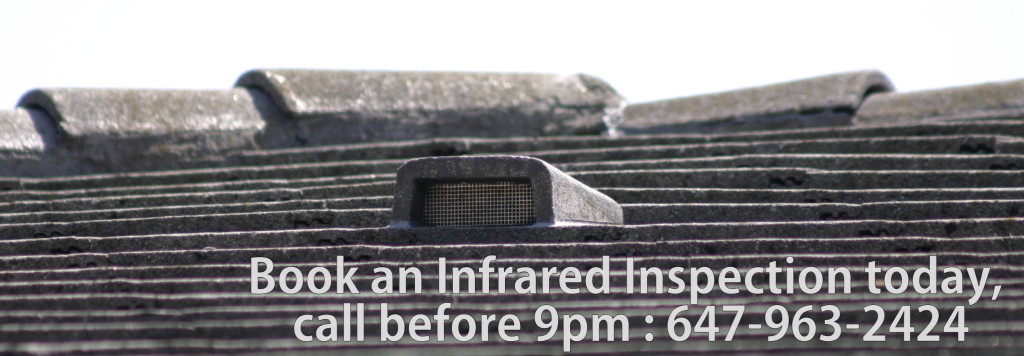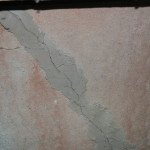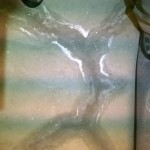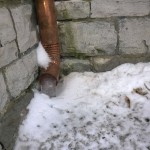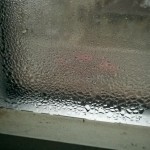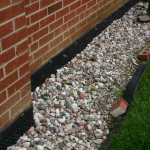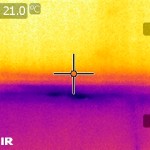Managing rain water, snow melt, water vapor and condensation around the house
Jan 23 2014 · 0 comments · Home Inspection- parging repairs is a good clue this basement wall had water penetration at one time.
- Cracks in the foundation floor. Efflorescence (white mineral deposits) indicates that water has been moving through the cracks.
- If water cannot discharge above, here is the reason. This condition can contribute to water damage on the roof eaves.
- This is common sight during the winter season. To reduce and eliminate this condition, ventilate the house and and exchange stale indoor air with fresh outdoor air. Use a HRV unit to recover heat.
- damp proofing membrane installed on an old home is a sure sign of water penetrating the basement.
- IR thermogram of basement floor wall intersection. The purple area is cooler, suggestion dampness, wetness. Moisture meter confirms water penetration at floor wall intersection.
If you trace back to the root cause of most damages around the house, they almost always leads back to water damage. This blog discusses where water damage occurs in the house and how we can manage water damage around the house. This is important because good water management around the house can prevent water damage around the house which can potentially cause structural and health problems.
Ideally, the house should be build on top of the highest grade compared to the surrounding to allow water to drain away from the foundation on all four sides. The grade around the house should slope 1 inch down for 12 inches horizontal for at least 6 feet away from the house. If the house is built on poor grading, such as next to a hill or at the bottom of a hill where water can run down towards and accumulate at the foundation, you can expect water issues around the house. Water proofing the foundation walls is a must in these situations. Also, it is recommended that trenches be installed to divert runoffs away from the foundation of the house in order to avoid hydro static pressure building up around the foundation. Should there be cracks in the foundation, water will enter the house through the cracks if there be enough hydro static pressure from the sides or under the foundation.
The are 4 main strategies to reduce the risk of water damage around the house. 1) reduce rain water entry from sky and ground. This means controlling rain and snow melt with overhangs, proper flashing, gutters and downspouts to divert the water away from the foundation. 2) control the temperatures of condensing surfaces by insulating to increase the R-value of that part of the house. 3) control unwanted air flows that carry moisture by sealing air leaks around the house. 4) Control moisture sources and indoor air pollutants with mechanical ventilation.
Where does all the unwanted water come from?
The exterior sources of water such as a leak in the roof or foundation can contribute. Leaks in flashings around roof and windows can also be source of unwanted water. Uninsulated air ducts can also be a source of unwanted moisture as water condenses on the cool surface, especially in the cooling season when the warm moist air comes in contact with a cool uninsulated surface of air ducts.
Water can also be wicked from concrete surfaces such as crawl spaces or foundations. This water source acts like a “pump” as moisture is wicked into the house, evaporated, exits the house via the stack effect only to draw more moisture from the foundation walls. A quick and easy test can determine where the water is coming from. Tape a 2 ft x 2 ft plastic sheet on the basement concrete for a few days, water droplets form on top of the plastic sheet, then moisture from inside the house is condensing on a the cool surface, if water droplets form under the plastic, moisture is moving from the concrete foundation into the house.
A family of 4 can produce 2-3 gallons of water from vapor just by breathing, washing, showering, cooking, and drying their clothes.
Why is all this moisture a problem?
The moisture in the air by itself is not a problem, in fact, it is comforting in the winter to breath humid air. The problem occurs during the coldest days of winter when that moisture condenses on cold surfaces around the house. Water is formed and if left unchecked, can cause damage to the surface and promote mold growth. These surfaces include wall sheathing, roof sheathing, window surfaces, poorly insulated walls and ceilings, insulated air ducts.
How to reduce water vapor.
Eliminate large sources that can be reduced or removed such as humidifiers, unvented combustion appliances, ground water evaporating from basement or crawlspace.
Use kitchen and bathroom exhaust fans to remove moist air from the house.
Provide controlled, continuous fresh-air ventilation. This gives effective dehumidification in cold weather.
Control the movement of vapor by using vapor retarders
